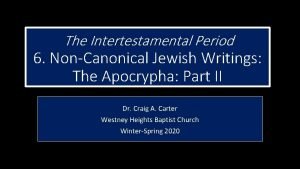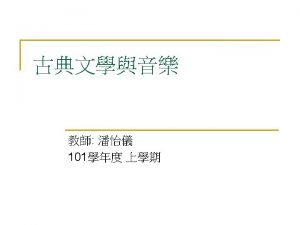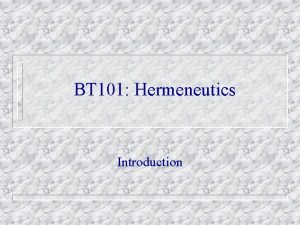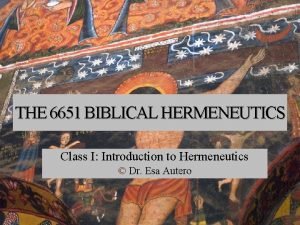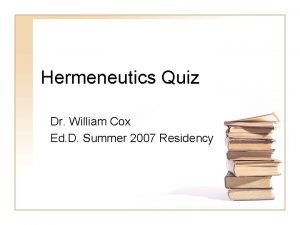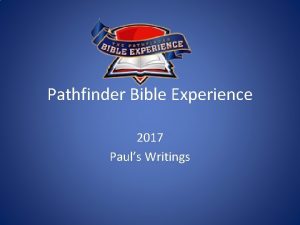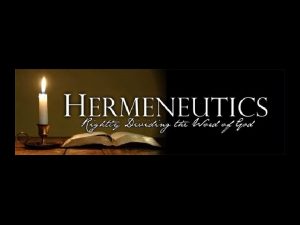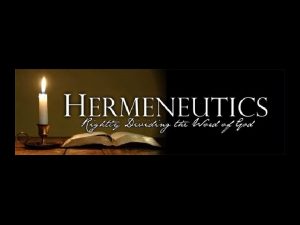Hermeneutics Interpreting Inspired Writings Correctly What is Hermeneutics















- Slides: 15

Hermeneutics Interpreting Inspired Writings Correctly

What is “Hermeneutics”? From Greek word, “to interpret” n A method of interpreting correctly n 2 Tim. 2: 15: “rightly dividing [handling] the word of truth. ” n

Three Simple Rules Study the general teaching n Consider time and place n Discover the basic principles n

1. Study the General Teaching Get the “big picture” n Include all that the Bible or Mrs. White has said on the subject before drawing conclusions n EGW: “The testimonies themselves will be the key that will explain the messages given, as scripture is explained by scripture. ” 1 SM 42 n

1. Study the General Teaching Bible example: eternally-burning hell? n Rev. 14: 11, smoke of torment forever n But that’s not the whole story n n n Rom. 6: 23: Wages of sin is death Mal. 4: 1: Coming day will burn them up Rev. 20: 6, 14: Wicked die second death Jonah 2: 6: “Forever” is only three days! Jude 7: Sodom suffered “eternal fire”

1. Study the General Teaching Disputes in church if ignore this first rule n Some take one statement, ignore balancers n n 2 T 400: “Eggs should not appear on your table” 7 T 135: “In some cases the use of eggs is beneficial” 9 T 162: “Eggs contain properties that are remedial agencies in counteracting certain poisons”

1. Study the General Teaching Disputes in church if ignore this first rule n Some take one statement, ignore balancers n n Kneeling for prayer “is the proper position always. ” 2 SM 311 “Not always necessary” to kneel. 2 SM 316; MH 510, 511 It is best to kneel in private devotions and for the main prayer for church.

2. Consider Time and Place Context, literary and historical n EGW: “Regarding the testimonies, nothing is ignored; nothing is cast aside; but time and place must be considered” 1 SM 57 n

2. Consider Time and Place n Immediate context (paragraph, page, etc. ) n n n People “should never be taught to say, or feel, that they are saved” (COL 155) Context: Warning re: “once saved, never lost” Context: Peter’s self-confidence, denial of Christ

2. Consider Time and Place n Context: “Never can we safely put confidence in self, or feel, this side of heaven, that we are secure against temptation. . . But even when we give ourselves to Christ and know that He accepts us, we are not beyond the reach of temptation. . Our only safety is in constant distrust of self, and dependence on Christ. ” (COL 155)

2. Consider Time and Place n EGW understood basis of assurance: “Each one of you may know for yourself that you have a living Saviour, that He is your helper and your God. You need not stand where you say, ‘I do not know whether I am saved. ’ Do you believe in Christ as your personal Saviour? If you do, then rejoice” (General Conference Bulletin, April 10, 1901)

2. Consider Time and Place Historical setting: “Not one in twenty” Adventists ready for judgment (3 T 471, in 1875) n Prediction? No. Statement of condition n Today might be better, or worse! n

2. Consider Time and Place Customs may differ: take off shoes? n Place: quote EGW in public? n Historical setting: bicycles n

3. Discover the Basic Principles vs. policies: universal truth vs. application of universal truth n Example: teaching girls to harness and drive a horse (Ed 216, 217) n Example: bicycle craze (TM 393, 8 T 51, 52) n Example: flesh food vs. vegetarianism n

4. Use Common Sense n EGW: “God wants us all to have common sense, and He wants us to reason from common sense. Circumstances alter conditions. Circumstances change the relation of things. ” (3 SM 217) “We are to be guided by true theology and common sense. ” (1 MCP 148)
 Which title best completes the graphic organizer?
Which title best completes the graphic organizer? Example of formal writing style
Example of formal writing style Intertestamental writings
Intertestamental writings Refers to writings in which expression and form
Refers to writings in which expression and form Hermeneutics 101
Hermeneutics 101 Critical race theory tenets
Critical race theory tenets Hermeneutics class
Hermeneutics class Geisteswissenchaften
Geisteswissenchaften Hermeneutic circle
Hermeneutic circle Hermeneutics quiz
Hermeneutics quiz The way my mother speaks carol ann duffy
The way my mother speaks carol ann duffy Inspired leadership initiative
Inspired leadership initiative The inspired
The inspired Invention imitate nature
Invention imitate nature What factors most inspired conquistadors to set sail?
What factors most inspired conquistadors to set sail? Moving figures inspired by futurism
Moving figures inspired by futurism


